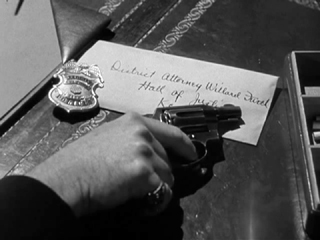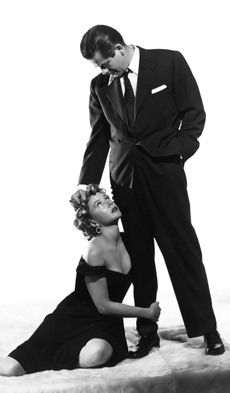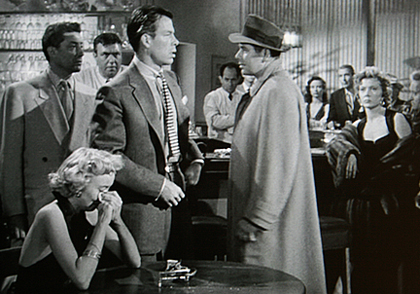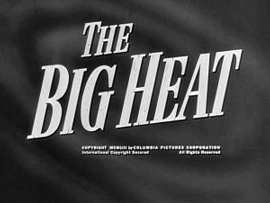
 |
|
|
|
A top-rank bona fide core title film noir in anyone's book, The Big Heat is considered by many to be Fritz Lang's best American film. More than most efforts in "the American style", this big city crime revenge story bears a strong connection to an earlier film form, namely German expressionism. It's not a matter of stylized sets or lighting. The Big Heat bears Columbia's early-50s sparse look that can be pretty much summed up by star Gloria Grahame's assessment of the décor in a cheap hotel room: "Oh ... early nothing." The Germanic element in Heat is the same manic fire for vengeance that motivates Lang's classic Die Niebelungen: when wronged cop Glenn Ford sets out to nail the men responsible for killing his wife, he tears the city of Kenport to pieces. We almost expect to hear the hysterical theme song from Lang's Rancho Notorious: "HATE, MURDER, and REVENGE!" 
Incorruptible Kenport detective Dave Bannion (Glenn Ford) scoffs at barfly Lucy Chapman (Dorothy Green) when she claims that police administrator Duncan's suicide was faked, that he was going to divorce his wife Bertha (Jeanette Nolan) to be with her. But Dave's suspicions are raised when Lucy is found dead, with marks of torture on her body. Bannion's police superiors and the widow Bertha indeed act as if under the direct influence of organized crime. This leads Dave directly to Mike Lagana (Alexander Scourby), Kenport's crime kingpin. When the cop refuses to back down, Lagana's associates Vince Stone and Larry Gordon (Lee Marvin & Adam Williams) strike out at Bannion's family, with fatal results. His personality changed, Dave gets himself fired from the police force and begins a personal investigation. Vince and Williams laugh in his face until he secures the help of two more vulnerable women. Crippled Selma Parker (Edith Evanson) helps narrow the identity of Lucy's killer. Playgirl Debby Marsh (Gloria Grahame) is impressed by Dave's intimidation of the swaggering Vince. She tries unsuccessfully to seduce Dave, and instead empathizes with his loss. Vince punishes her disloyalty with a horribly painful act of violence. The Big Heat begins with a shot almost identical to one from Lang's Metropolis, a quarter-century before: a suicide by revolver, showing only the gun lying on an executive's desk. The film does not really follow the semi-docu police procedural noir style that dominated the '50s, but is instead another one of Fritz Lang's intense, interrelated stories of cruelty and retribution. Dave Bannion is the good cop in a rotten city. The Police Commissioner plays poker with organized crime thugs, and anybody impeding business is found in a ditch outside of town, or floating in the river. Despite the inroads of socially conscious play adaptations like Detective Story, The Big Heat has little to say about ethnic or social pressures. The police precinct isn't packed with juvenile delinquents or drug addicts. We get the idea that Kenport might be Utopia, if it weren't for those scummy mobsters. The only class-consciousness we see is totally cop-centric. Dave Bannion lives in a modest house with a stay-at-home wife (Jocelyn Brando, an appealing domestic partner), while the slimy Lagana has achieved riches and celebrity. The police provide free security for his teenaged daughter's fancy parties. When Bannion's own daughter is threatened, Lagana can have her protective guard removed with just a phone call. Lagana is in the same league as the less visible power broker Noah Cross of Chinatown: you can't call the police for protection against him, because he owns the police. 
Pick up most any book on film noir and you'll find an enthusiastic discussion of The Big Heat. The structural brilliance of the plot is usually credited to Lang, but it's mostly all there in William McGivern's book. Lang's contribution is to focus on the ironies and the parallelisms, like the 'protect my daughter' theme mentioned just above. Debby Marsh and Bertha Duncan are indeed "sisters under the mink", a sorority that poor Lucy Chapman never gets a chance to join. Debby is converted from a good time girl seeking nothing more than "expensive fun", into a Kriemhild-like avenging demon, paying Vince back with the very same violence he directed at her. And of course, "the big heat" of the title refers not only to the hoped-for blast of justice that will wipe out organized crime in Kenport (now that's a fantasy) but to the scalding that converts Debby from a bimbo into a committed warrior. Buried in the macho vengeance theme (with special guest female revenge) is a veiled criticism of Dave Bannion's self-righteous crusade. Whether acting as an honest cop or fixated on hateful payback, Bannion's efforts consistently put women in harm's way. He pays little attention to Lucy Chapman's plea for help. Dave ought to realize that Lagana has a long reach, but two more women come to a sad end just for knowing him. The only real survivor is another bar girl, Doris (Carolyn Jones). Dave happens to be present when Vince Stone burns her with a cigarette in front of a dozen intimidated witnesses. Bannion 'comes to her defense' but offers her only a cursory check-up as she sits crying at a bar table. You'd think he'd be more solicitous considering that he previously ignored the equally innocent Lucy. No, he's on his noble quest, and they're just women of the night. Bannion's more in his element when punching out villains, terrorizing men and women alike. He cynically sets up the cheap hood Larry Gordon to be rubbed out by his own men. Dave puts on the pressure but it's really other people that take the big risks. Dave busts open the Kenport syndicate, yes, but at a very high price. 
The Big Heat is a solid entertainment. Fritz Lang's direction stays at a "just the facts" remove until confrontation scenes crop up, at which point he moves in for tight, sometimes erratic compositions. The violent scenes derive their tension simply by framing faces tighter. Glenn Ford was never better. He does some of his best playing when the cracks show in his hatred, and he becomes sentimental about the woman he's lost. Fifth-billed Lee Marvin is sensational as the cocky lout-in-an-expensive-suit, a syndicate creep who mistreats women and thinks he's impervious to the law. But the best performance comes from the capricious Gloria Grahame. An actress with a woefully scrambled personal life, Grahame conveys Debby Marsh as an immature girl, an accomplished tease and a lost soul looking for a real relationship. Her self-identity destroyed by an act of mutilation, Debby discovers her new potential for hate, and becomes the movie's most unstoppable force. The finale is unusually disturbing. Debby and Dave can't get together for obvious reasons. Twisted Hollywood glamour logic subscribes to the notion that mutilated women have to disappear, and the Production Code mandates that sexually promiscuous "bad women" must be severely punished, often with death. As a "moral warrior", Dave Bannion appears to be immune from such criticism. Frankly, Dave needs to atone for his moral selfishness by spending some time helping women given a bad deal by society. I believe that this unspoken conflict gives Lang's movie an extra twist of tension. The Twilight Time Blu-ray of The Big Heat is a sterling transfer, buffed to near perfection by the Sony restoration department. This title always looked good on home video but here we can pick out fine details of Gloria Grahame's makeup. Some older presentations (the laser disc, for one) over-modulated the music track, but here things seem to be back at their proper levels. The late-1953 release of the studio-produced The Big Heat would indicate a widescreen Aspect Ratio. The transfer is presented at the flat-Academy ratio, 1.37:1, which normally cues Savant to go into a lecture about home video departments going cheap with 50s films and avoiding making a separate transfer for home video. Heat's main titles are wide blocks high in the frame, suggesting that a 1:85 or 1:66 crop is the proper Aspect Ratio (see below). Despite that I think the flat transfer is correct. The lower extreme of the frame can be matted off, but the movie never has that feeling of large empty spaces top and bottom. Tighter framing would definitely compromise other scenes. Fritz Lang was no early adopter of new formats, and I think it very possible that the show snuck in under the wire for the format changeover. 
But what about the shape and position of the title text blocks, which I often rely on as evidence for the intended AR? Having watched so many releases from this year, I think that The Big Heat was shot for the Academy frame and probably first exhibited that way. Then, later in its release or perhaps in a reissue the next year, the title text blocks were re-shot to fit. A good example of this is the 1953 Columbia film From Here to Eternity, a popular release that surely played for at least a year in sub-runs. The Zinnemann film is definitely 1:37 Academy. Any attempt to matte it wrecks the composition of almost every shot. Yet Eternity has the same wide title text blocks, high in the frame. A still exists of an Eternity marquee promising stereo sound and widescreen projection. I feel sorry for the projectionist, sitting watching the movie and racking the film up and down, trying to compensate for the newly imposed widescreen format. 1 2 Frankly, I've also always been impressed with the Sony restoration department's careful attention to Aspect Ratio. I was in their shipping room about ten years ago and saw stacks of HD feature transfers. Each title had at least five versions: flat, letterboxed, 16x9... with down-conversions in both PAL and NTSC. Only once or twice have I noticed a vintage Columbia-Sony feature title released with a wrong aspect ratio. When it happens, it's probably because of a mistake in the Home Video department. Finally, the original trailer for The Big Heat reveals big text blocks that fill the whole screen, all definitely formatted for standard Academy 1:37. I am now convinced. Besides the trailer, Twilight Time includes a full Isolated Music score. I didn't hear any vocal IDs in the first ten minutes, but it's definitely not an adapted M&E track. These tracks are a real bonus, turning each movie into a mini-concert for soundtrack fans. I only hope that if and when some fabulous title comes along for which no separate music element is available, that TT will put it out anyway. Career writer Julie Kirgo outdoes herself in her liner note essay. An original contributor to the prime reference book Film Noir: An Encyclopedic Reference to the American Style, Ms. Kirgo gives The Big Heat not a light overview, but an insightful and reasoned critique that can stand beside anything written on the film. The essay's enlightened observances enhance our appreciation for Fritz Lang's noir masterpiece.
On a scale of Excellent, Good, Fair, and Poor,
The Big Heat Blu-ray rates:
Footnote:
1. Another example of a flat movie "altered" to be widescreen: On TCM I saw Carol Reed's The Man Between, from 1953. Shown in widescreen, it crops off well enough to 1:78 . But the title sequence was stretched out horizontally. The titles are shots of airplanes parked at an airport. Since the title text blocks were too tall to mask off, the Telecine people simply stretched them wider. The text looks a little distressed and the airplanes distorted. I'd say this re-format was probably done for a film reissue, a couple of years after initial release: the originally flat movie was re-jiggered for widescreen projection.
2. So I was right after all ... authority Bob Furmanek offers "the last word": Hi Glenn, The Big Heat began filming on March 17, 1953. Columbia, as a matter of studio policy, changed to 100% widescreen cinematography on April 7, 1953. Their studio ratio was 1.85:1. It was one of many un-released features when the widescreen revolution hit theaters all over the country in the summer of 1953. When released on October 14, 1953, Columbia suggested exhibitors present it in 1.85:1. That's why the titles are placed higher than usual so the operator would frame up in order to favor the top portion of the image.
However, 1.37:1 is the correct ratio for The Big Heat. Best, Bob
Reviews on the Savant main site have additional credits information and are often updated and annotated with reader input and graphics. Also, don't forget the 2011 Savant Wish List. T'was Ever Thus.
Review Staff | About DVD Talk | Newsletter Subscribe | Join DVD Talk Forum |
| ||||||||||||||||||